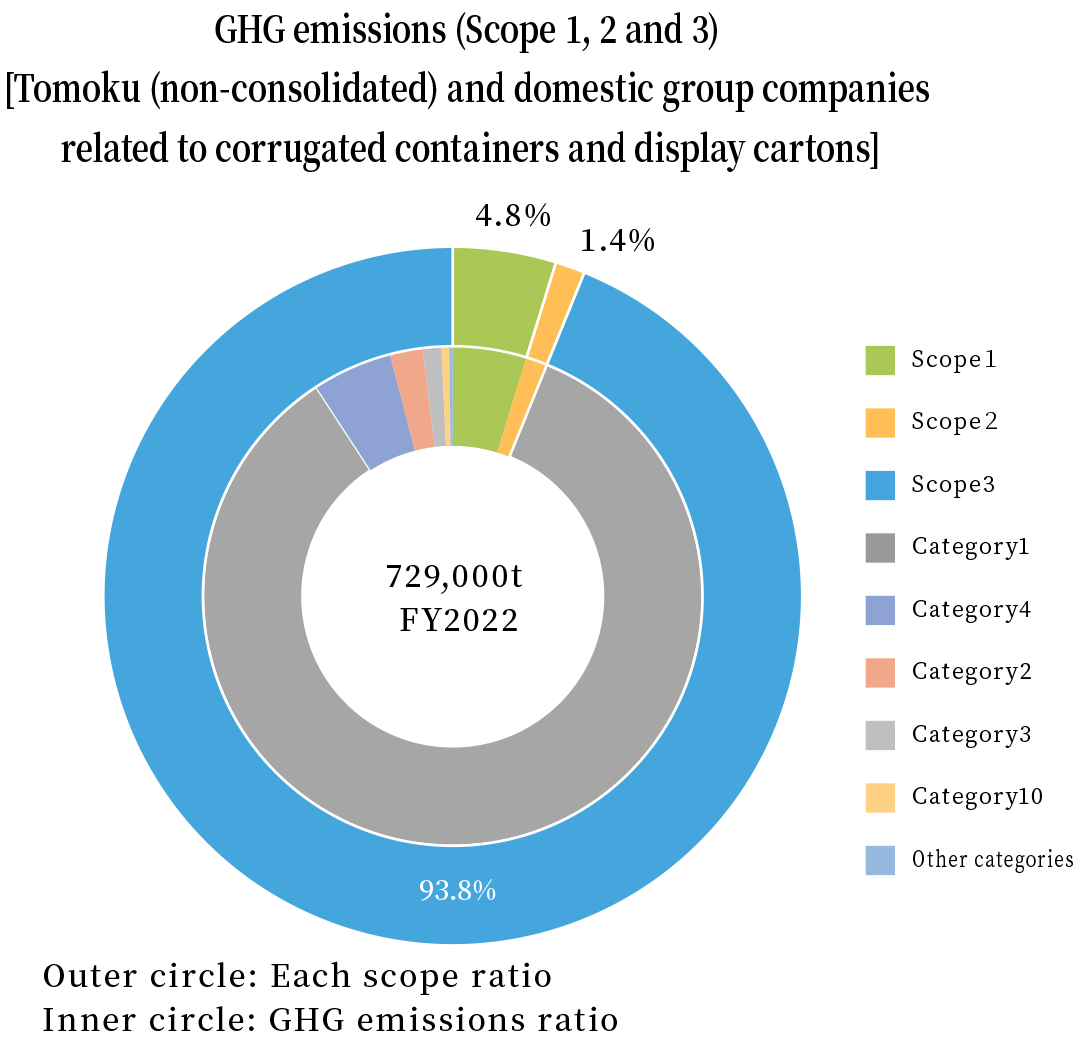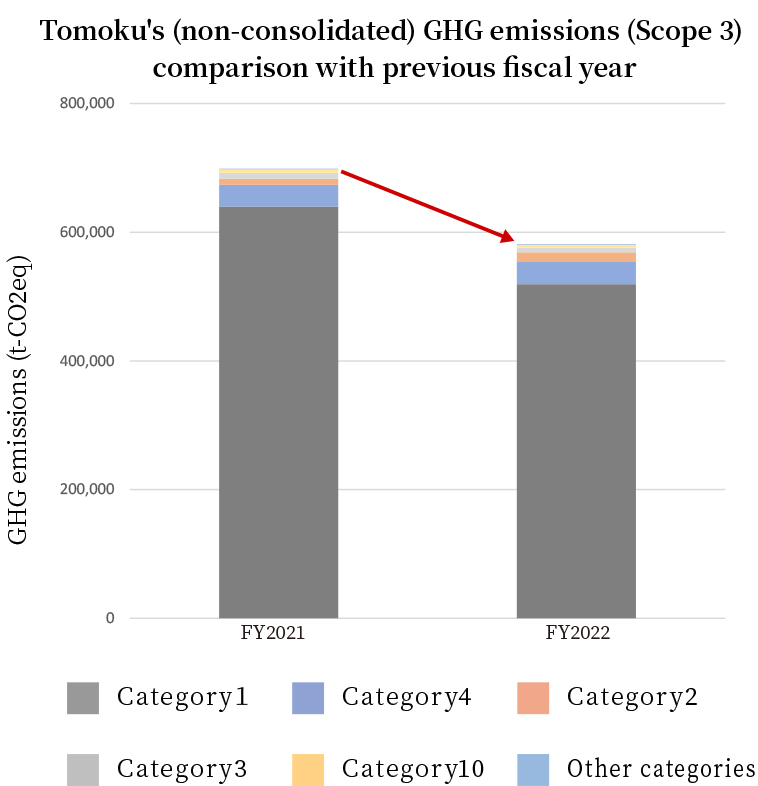CSR/SustainabilityCSR ・ Sustainability
Disclosure Based on the TCFD Recommendations

-
The Tomoku Group will continue to enhance the quality and quantity of information disclosure based on the TCFD recommendations that we started last year.
According to the IPCC’s 6th Assessment Report in August 2021, anthropogenic greenhouse gas emissions have increased, and the global median surface temperature has risen by 1.09°C from the pre-industrial period to the 2011-2020 average, and that it is unequivocal that human activities have warmed the atmosphere, the ocean, and the land.
Global warming is changing the climate and having a major impact on the global economy, society, and environment. We also recognize that reducing greenhouse gas emissions, a major factor in global warming, is an urgent challenge for sustainable growth. We will continue to actively disclose our initiatives and work to improve corporate value going forward.
1. Governance
-
The Tomoku Group, considering the response to climate change to be one of our key corporate issues, manages these initiatives within the Sustainability Committee chaired by the President & CEO.
The Committee meets four times a year, with the participation of directors and officers. The TCFD Disclosure Project Team (hereinafter referred to as the TCFD Disclosure PT) has been established under the Committee as a subordinate organization to address climate change issues.The TCFD Disclosure PT consists of the directors, officers, and managers of the corrugated container and display carton operations, the housing operations, and the transportation and logistics operations of the Group's major companies.
The Committee deliberates on and approves TCFD Disclosure PT proposals and reports, as well as provides instructions and advice to each division or company in the Group, when it is required.The Committee reports to the Board of Directors at least once a year on the state of broader sustainability initiatives, including those related to climate change, and the Board of Directors deliberates on and makes resolutions on the progress (Figure 1).

Figure 1 Governance
2. Risk Management
-
The Tomoku Group has established, developed and operates a comprehensive risk management system overseen by the Financial Risk Committee, the Compliance Committee, and the Sustainability Committee chaired by the President & CEO (Figure 2).
We regularly assess risk across the Group and separately identify high-priority risks within each committee while determining serious risks across the Group, then deliberating on and presenting resolutions to the Board of Directors.
Every Committee manages serious risks, meeting twice a year, even though each of the Group's companies plans and implements countermeasures based on the type of risk.

Figure2 Risk Management
Materiality
-
The Group has selected twelve materiality issues by classifying important issues from the perspective of their impact on all stakeholders and on the Group. We also carry out relative risk assessments, and we will work to resolve these materiality issues through business operations to contribute to a sustainable society (Figure 3).
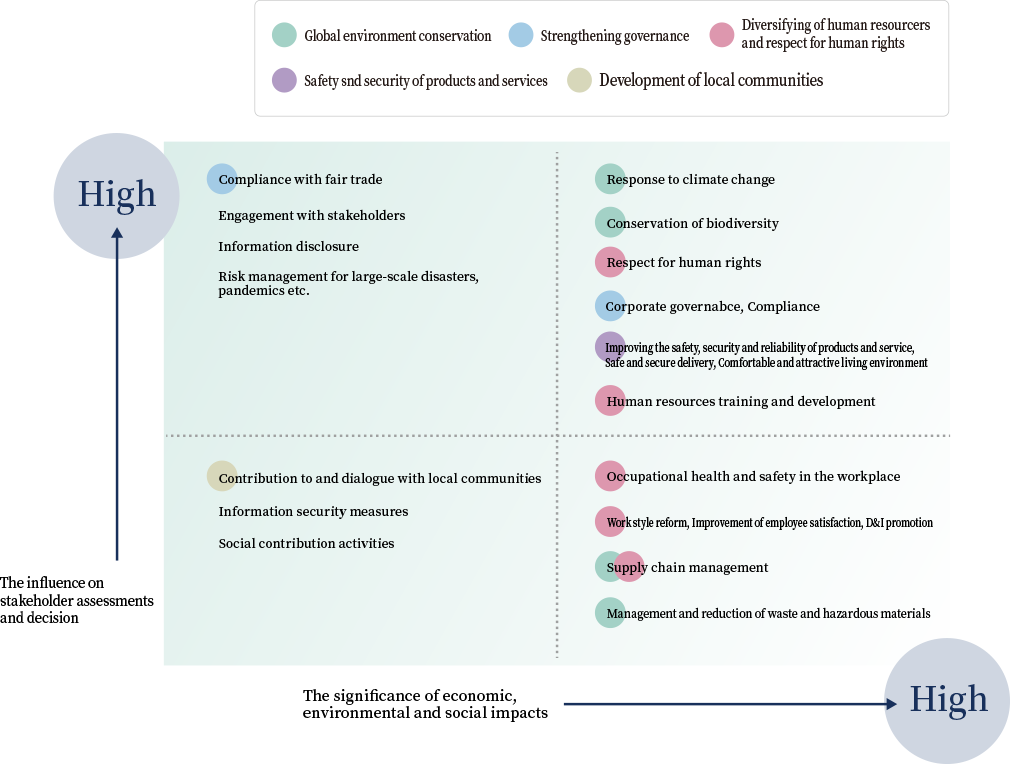
Figure 3 Materiality Issues
3. Strategy
- 3-1 Selecting Businesses
-
Using scenario analysis, the Group identifies the main risks and opportunities related to climate change, then within the Committee assesses their financial impact.
For the scenario analysis, last year we selected the domestic corrugated container and display carton segment (Tomoku non-consolidated), which has the highest sales and operating profits in the Group, but this year we added domestic group companies* related to corrugated containers and display cartons to the assessment scope of last year.
Using the two future scenarios of 4°C and 1.5°C, we measured their impact at the 2030 point based on the results of FY2021.
We plan to continually improve the accuracy of scenario analyses to expand the scope of assessments, such as the housing and the transportation and logistics segments, updating the financial data. We will also strengthen the resilience of our business for an uncertain future by integrating the results of our analyses into our management strategy.**If there is no inferred data in the 1.5°C scenario, use the 2°C scenario
-
Business
Domestic corrugated container and display carton (domestic non-consolidated and related group companies)
Reason
Main business of the Group
*Domestic group companies related to corrugated containers and display cartons, 15 companies
Consolidated subsidiaries - Wako Co., Ltd.
- Tokachi Package Co., Ltd
- Sendai Shiki Kogyo Co., Ltd
- Toshin Package Co., Ltd
- Daiichi Container Co., Ltd.
- Taiyo Co., Ltd
- Hokuyo Co., Ltd
Unconsolidated subsidiaries - Shimizu Danboru Co., Ltd.
- Nansai Shiki Co., Ltd.
- Atsuta Shiki Co., Ltd.
- Kadoma Shiki Co., Ltd.
- Ota Danboru Co., Ltd.
- Sekiya Co., Ltd.
- Enshu Kami Kogyo Co., Ltd.
- Nichiei Shikou Co., Ltd.

- 3-2 Scenario
-
For assessing the financial impact, we set up the following scenarios.
Timeline: 2030
Projected world Projected world in which global warming is limited by policies Projected world in which climate change by global warming is getting worse 1.5℃ Scenario 4℃ Scenario Outline A scenario in which global warming by 2100 is limited to 1.5°C above the late 19th century. The Group will be affected by transition risks such as carbon taxes due to regulatory tightening. On the other hand, the impact of physical risks is relatively small compared to the 4°C scenario. A scenario in which global warming by 2100 rises to 4°C above the late 19th century. The Group will be affected by physical risks such as the intensification of extreme weather.
Since there is no regulatory tightening on climate change, the impact of transition risks is small.Scenario Transition IEA Net Zero Emission by 2050 (NZE)
IEA Sustainable Developement Scenario (SDS)IEA Stated Policies Scenario (STEPS) Physical IPCC RCP 2.6 IPCC RCP 8.5
- 3-3 Risks, Opportunities, and Initiatives
-
We started by identifying the expected risks and opportunities. We then summarized the most significant risks and opportunities by ranking them into three levels: low, medium and high.
We selected the 1.5℃ scenario that is expected to have a significant impact on transition risks, and the 4℃ scenario for physical risks. We are committed to continue our current initiatives to minimize environmental impact, as shown in Table 1.
Table 1 Risks, Opportunities, and Initiatives
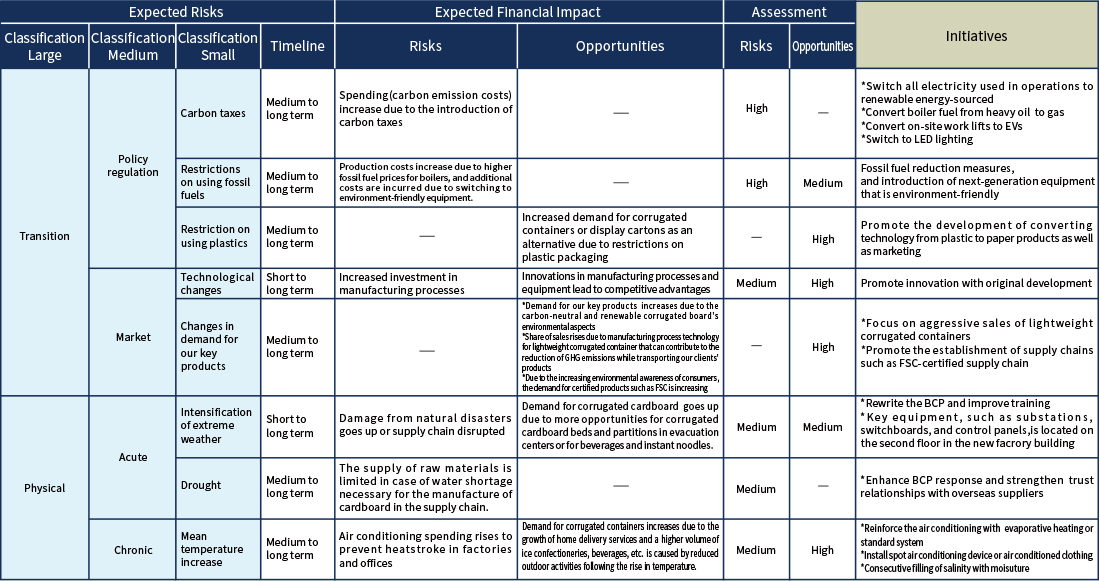
- 3-4 Assessing the Financial Impact
-
References
| Carbon taxes | IEA WEO 2022* |
|---|---|
| Fossil fuel prices | Calculated prices of city gas, light oil, heavy oil, LPG based on the crude oil prices in the IEA WEO 2022*. |
| Electricity prices | IEA WEO 2019* |
| Flood damage** | Calculated flood damage based on depreciable and inventory assets per person in the selected businesses' financial results in FY2021 with reference to the 'Flood Hazard Map (as of Apr.2023)', the 'Flood Control Economic Survey Manual (Apr.2020)', the 'Technical Criteria for River Works -Practical Guide for Planning-' published by MLIT***, the 'Proposal for Flood Control Plans based on Climate Change' reported by the Technical Review Committee on Flood Control based on Climate Change, and the 'Practical guide for Scenario Analysis in line with TCFD recommendation v3' published by MOE**** |
| Business suspension** | Calculated business suspension based on value added per person in the selected businesses' financial results in FY2021 based on the same calculation procedure as flood damages |
| Storm surge damage | Calculated storm surge damage based on the same procedure as flood damage after identifying the depth of inundation with reference to the 'Cost-Benefit Analysis Guidelines for Coastal Projects' published by MLTI and MAFF*****, the 'Flood Control Economic Survey Manual (Apr.2020)' published by MLTI, and the 'A Study on the Simultaneous Occurrence Probability of Tsunami and Storm Surge' published by the Japan Society of Civil Engineers. Although there were some damage sites, they were not included due to the absence of assets and zero damage. |
* International Energy Agency World Energy Outlook,Exchange rate 109.75 yen/USD
** Calculation of 1 year average damage
***The Ministry of Land, Infrastructure, Transport and Tourism
****The Ministry of the Environment
***** The Ministory of Agriculture, Forestory and Fisheries
Results of the Financial Impact Analysis for Each Scenario
We applied the two kinds of scenario for 2030 to the results in FY2021 and predicted the impact amount.
The expected operating profit for each scenario was shown before and after the achievement of the 2030 greenhouse gas emissions target (50% reduction compared to 2013).
In the 1.5°C scenario, the impact of government regulations such as carbon taxes is the most significant. By achieving the emission reduction target, this impact can be mitigated, but the impact by Scope 1 remains. In the future, it will become more important to reduce greenhouse gas emissions from boiler fuel sources.
In the 4°C scenario, regardless of whether the reduction target is achieved or not, the impact of fossil fuel prices and flood damage will be significant, and strengthening BCP will become even more important.

4. Metrics and Targets
The Tomoku Group has set numerical targets for addressing climate change as a significant management issue.
To meet our group targets, we will continue to promote the introduction of facilities that can reduce fossil fuels and save energy, as well as the conversion to renewable energy-sourced electricity and to other fuels.
Furthermore, from FY2023, we have converted all the electricity used at the 17 factories of Tomoku (non-consolidated) to renewable energy-sourced electricity.
| Reduction of GHG Emissions | A 50% reduction compared with 2013 by 2030 (Scope 1 and 2) |
|---|---|
| Ratio of renewable energy sources in electricity consumption | 100% by 2030 |
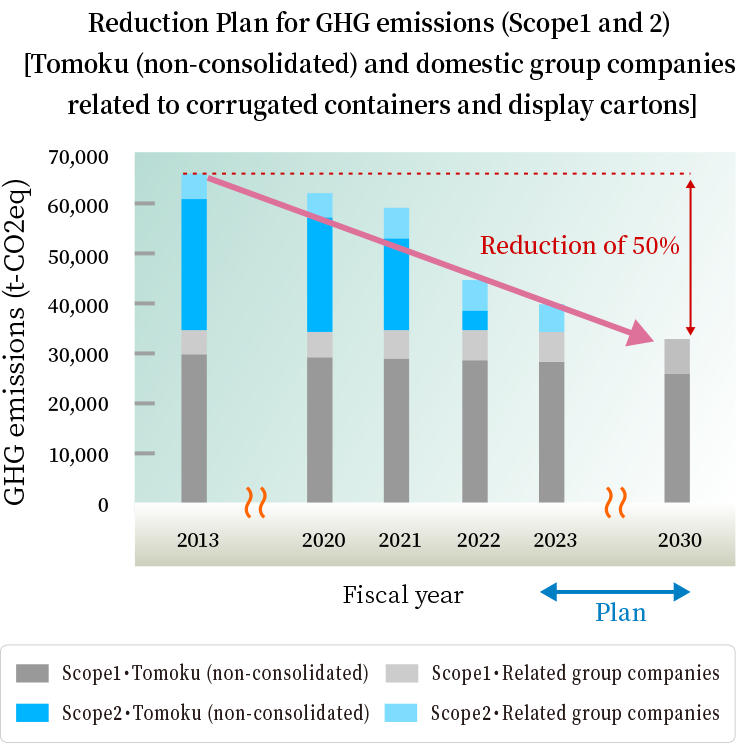

About 94% of the supply chain emissions of 729,000 tons in FY2022 by Tomoku (non-consolidated) and domestic related group companies is due to Scope 3, and about 90% of that Scope 3 is due to Category 1.
The significant reduction of about 17% in Tomoku’s (non-consolidated) Scope 3 emissions compared to FY2021 is due to the decrease in containerboard emissions (secondary data) in FY2022.
We will continue to reduce the GHG emissions of major raw materials (such as containerboard) in collaboration with containerboard manufacturers.
